
|
WILLIAM COONS
Bill is a product of the depression era and is originally from Churchtown, NY, about a 110 miles north of New York City. 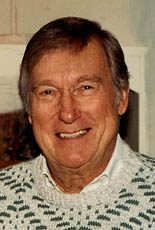
His mother and father had a fifth grade education and they had to quit school to help on the farm. Part time jobs put food on the table and the church owned the house they lived in.
Bill and his family eventually moved to Hudson, NY, where his father started a new job as a house painter and Bill enrolled in grammar school. Into many different jobs during his teen years, his passion became art and music.
He was sixteen when he started to think about flying. He joined the "Pre-Flight Club" where he learned how to identify enemy aircraft, build scale models and learned how to use Morse code. He also got interested in Ham radio.
He read an ad about a school to open by the Army and Navy, to teach Aviation Mechanics. He quit high school and signed up for the class. After graduation in 1944, he reported to the Navy induction center. He had just turned seventeen. In the Navy and after learning all about radios and how to shoot guns, he was transferred to Ft. Lauderdale where he was supposed to start training as a gunner in the back seat of a Douglas Dauntless dive bomber.
After weeks of training he was off to San Diego, as he was assigned to an aircraft carrier.
Then, he fell ill with scarlet fever and his squadron shipped out, with someone else in his place.
He was then flown to Santa Ana, California and became a member of VU7-A, a radio controlled target aircraft squadron. Much of what Bill did is in his book, "Shoot only at the Red Airplane". All navy drones are painted red. In October 1947 his enlistment was over and he returned to civilian life. In his spare time he continued to keep up with his music, flying, Morse code and art work.
Bill also started a country band and continued with his art work. In 1956 he was elected president of the Arts and Crafts Guild. He also studied photography and was the official photographer for Model Airplane News magazine and did over 23 magazine covers. In 1952 he taught photography for the Hudson School System Adult Education Program.
1968 found Bill moving to Lombard, Illinois and channeling his talents toward aviation art. He finally got his Ham radio license and started to teach Ham radio and had many students in his class.
He started taking flying lessons at age sixty and soloed in 10 hours.
In 1995 Bill received the National Ercoupe Fred Weick Award, for contributing the most to the upkeep and flying of the Ercoupe, from among several thousand Ercoupe pilots in the Association. Bill was writing articles about flying and the FAA asked him to become an Accident Prevention Counselor and he did.
He became interested in GPS navigation for pilots and his first seminar was to teach GPS to the FAA personnel. He was conducting two seminars a month and in 1994 received the "Great Lakes FAA Safety Counselor of the Year Award." Two years later he was inducted into the "FAA Premier Group," shared by only eleven other counselors in the country.
Bill also produced a Video sponsored by the FAA and he has received many awards over the past years for his volunteer work, especially his GPS seminars which have been outstanding.
In April of 2005 he was diagnosed with Pulmonary Fibrosis ( terminal ) and doctors gave him two years to live. It is now four years later and he has survived it all. He says he has been blessed with many good fortunes, especially his wife Spider, four children, many grand children and great grand children. His wife Spider says, " You have already lived three lives.
|
|
ARNOLD ZIMMERMAN
Arnold started flying more than 55 years ago. He holds commercial, instrument, Glider and Seaplane 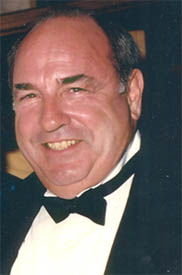 ratings. ratings.
He has been flying his Breezy aircraft for 35 years. He estimates that he has given over 12,000 Breezy rides. He has given free rides at Oshkosh the past 20 years. Over 1074 Young Eagle missions have been recorded and he has introduced numerous other youngsters to aviation.
He presently owns a 1946 Aeronca Champ, a 1969 Piper Aztec and a 1998 Breezy that he built.
Arnie received the "Wright Brothers Master Pilot Award" for flying over 50 years without an accident in November of 2005.
He also received the Phillips 66 Humanitarian Award with Chuck Yeager.
Arnie continues to fly and is currently involved with establishing the Illinois Aviation Museum at Bolingbrook which focuses on educating our youth on aviation engineering, mechanics and piloting.
He has been a donor of free rides in his Breezy to the Du Page Children's Museum.
A few years ago they raised over $250,000, a record breaking amount. This success was due in part to the one hour ride in a "Breezy" that Arnie donated. Arnie was also nominated for 2009. |
|
WILLIAM E. “BILLIE” SOMERVILLE
1869-1950
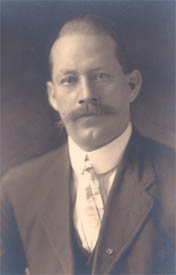 William E. Somerville was born in Scotland in 1869 where he attended Glasgow Technical College and became an electrician and marine engineer. He came to America in 1892. After various employment with the Biddle family in Philadelphia, where he received his more formal engineering education, he was hired to install an electrical generating system for a mining operation in Thurber, Texas. Billie arrived in Coal City Illinois in 1893 to attend his brothers funeral, who was killed in a mining accident and Billie never left. Coal City supplied much of the coal production consumed by Chicago in the late 1800's and early 1900's.
Billie was also employed as the village’s first electrical engineer and served in that capacity until 1900. William E. Somerville was born in Scotland in 1869 where he attended Glasgow Technical College and became an electrician and marine engineer. He came to America in 1892. After various employment with the Biddle family in Philadelphia, where he received his more formal engineering education, he was hired to install an electrical generating system for a mining operation in Thurber, Texas. Billie arrived in Coal City Illinois in 1893 to attend his brothers funeral, who was killed in a mining accident and Billie never left. Coal City supplied much of the coal production consumed by Chicago in the late 1800's and early 1900's.
Billie was also employed as the village’s first electrical engineer and served in that capacity until 1900.
 |
Billie Somerville’s Biplane |
He became electrical superintendent of the new Macomber Whyte Company, manufacturers of hand woven hemp rope and wire rope at a plant in Coal City. Billie soon developed new hemp rope making machinery and also wire rope machinery. He also held many patents and eventually became plant manager of the company. He was elected Mayor of Coal City in 1905 and again in 1925.
In 1908 he worked on scale models and in 1910 developed a biplane and also held patents on many aviations inventions.
He cut back on his work load at Macomber Whyte in 1911 and devoted more time to his aviation endeavors. He leased 160 acres on the western edge of town for a landing field and built three hangars next to the German Baptist Church located on the property. Also in 1910 he organized the Illinois Aero Construction Company with some local businessmen. It was initially capitalized at $ 250.000.
Billie experimented and flew gliders with Octave Chanute at the Indiana sand dunes. ( Told to Clancy Hess by Billie Somerville)
Billie built seven of his aircraft on the airfield while the Wright brothers were still in Europe. In 1910 he built a biplane that held seven people including the pilot. Many feel this was the very first tractor type aircraft ever built. This aircraft was flown to a height of 1800 feet by one of Somerville’s pilot’s Earl Daugherty.
 |
|
Billie Somerville At The Controls
|
In addition to the patent court fights with Glenn Curtiss, the Wright brothers also went to court against Billie for patent infringements. The judge threw out the Wright’s claims against Billie, as he had stronger patents. One of the patents Billie held was for the upward curved wing tips which he patented in 1910. Today they are called Winglets and are found on many modern private, commercial and business aircraft.
( Patent infringement case told to Clancy Hess by Billie Somerville )
Billie Somerville inaugurated the first city to city Airmail Service in the United States. ( First mail delivery was also claimed by Earle Ovington who on September 23 1911 flew 6 miles in six minutes, from Long Island and dropped a bag of mail over Mineola.) The bag burst open on impact, but the mail was retrieved.
George Mestach, a Belgian pilot, flew for Billie in his Somerville Monoplane.
On April 10, 1912, Mestach flew the mail between New Orleans and Baton Rouge, Louisiana in 1 hour and 32 minutes. Although he ran into a fence and broke the propeller upon landing on the Louisiana State University campus, Mestach managed to deliver a letter to Governor J. Y. Sanders. The next day, April 11, he flew the mail from Baton Rouge back to New Orleans.
At an air meet at Cicero Field, Chicago, on September 12, 1912, George Mestach in his Borel- Morane aircraft, was in a mid-air collision with a Wright Biplane, flown by Howard Gill. Gill was killed in the crash and Mestach landed his aircraft and was also injured, but not severely.
Around January of 1913, Billie bought the Borel- Morane from George Mestach at an auction. Mestach continued to fly for Billie in Illinois, Iowa and Wisconsin during July, August and September of 1913. Sadly, he smashed the airplane at an air show in Albuquerque around October. Somerville put the aircraft up for sale
but found no takers. He may have rebuilt it in 1913-1914. Earl Dougherty bought the airplane in late July or early August of 1914.
 Billie also built his first monoplane and called it the Somerville Monoplane. It was similar in appearance and design to a Borel- Morane aircraft. Some historical papers have called it a Somerville-Borel Monoplane.
He curved the wing tips upward and he also developed a interlocking control system he termed “auto-stabilizing,” which incorporated wing-slots with shutters, the net effect of which he contended, was that in a spin, the pilot could release thecontrols and the airplane would automatically return to level flight. Billie also built his first monoplane and called it the Somerville Monoplane. It was similar in appearance and design to a Borel- Morane aircraft. Some historical papers have called it a Somerville-Borel Monoplane.
He curved the wing tips upward and he also developed a interlocking control system he termed “auto-stabilizing,” which incorporated wing-slots with shutters, the net effect of which he contended, was that in a spin, the pilot could release thecontrols and the airplane would automatically return to level flight.
In the summer of 1913 Illinois Aero Construction Co. signed a barnstorming contract with the Western Vaudeville Association for the Spring and Summer of 1914. However, on December 24, 1913, a mysterious and disastrous fire destroyed all the company buildings, five completed airplanes and all the designs, patents, and tools. It was said that Billie's competitors were responsible for setting the fire, or someone from town that did not like airplanes. The most reasonable explanation is, that the hangars were along railroad tracks of the Santa Fe and sparks from the passing coal locomotive ignited the buildings.
At any rate a used Boral- Moraine airframe was purchased and fitted with a Gnome engine to fulfill the circuit contract.
 |
 |
Billie hired Earl Daugherty from California to be his pilot for the mid-west area. Earl competed with theLockheed brothers who were also barnstorming the area. Daugherty flew the contract and returned to Cicero Field for a final exhibition on August 15,1914.
Earl eventually dismantled the Borel-Morane and trucked it back to California.
In 1928, Earl along with two others, died in a mid-air with a flock of seagulls.
Stored for quite a few decades, the Borel-Morane was acquired in 2002 by the Canada Aviation Museum in Ottawa, Ontario Province.
The Illinois Aero Construction Company shut down operations and Billie purchased the property which would later house the Somerville Engineering Company, engaged in wire rope machinery manufacturing. Clarence (Clancy) Hess, from Lockport Illinois, Illinois Aviation Hall of Fame Member, met Billie in the late 30's, before World War II and Billie gave him many photo's of his aircraft, hangars, airfield, engines he built; including the Somerville Monoplane with the Winglets and much information regarding his aviation life.
Many will claim the very first airfield was in Coal City, Illinois.
Somerville was also an accomplished musician. He founded and directed the Coal City Marine Band and as a member of the Pullman Marine Band, he appeared several times as a guest clarinet soloist with John Philip Sousa’s band.Billie
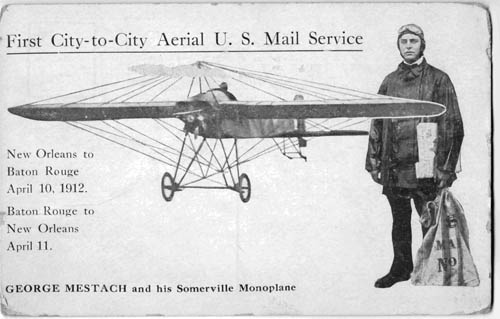 Somerville passed away September 25, 1950 at the age of 81. He is buried in Mount Olivet Cemetery in Wilmington, Illinois. Somerville passed away September 25, 1950 at the age of 81. He is buried in Mount Olivet Cemetery in Wilmington, Illinois.
|
|
|
RICK A. WEINBERG
(Deceased 8/7/2003 )
Rick A. Weinberg worked at the University Of Illinois Institute Of Aviation for 34 years, with the primary 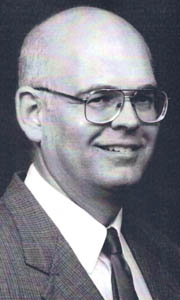 duty of working with the youth of Illinois who were seeking aviation careers. duty of working with the youth of Illinois who were seeking aviation careers.
He was a student at the University of Illinois and after graduation he was hired by the school as a full time flight instructor. After that he worked for Britt Airways for a short time, then returning to the school as a full time Flight Instructor and Basic Group Supervisor, along with other administrative duties. After the retirement of Omer Benn in 1990, Rick became Chief Flight Instructor.
Rick was the 1994 Flight Instructor of the year, Great Lakes Region. He was the sought after speaker at Safety Seminars at Champaign and throughout the state. Rick participated as an instructor in the Wings Weekend programs. He developed aviation curriculum for the University of Illinois Flight School.
Rick was an FAA Accident Prevention Counselor. He served as Chief Pilot for the Institute of Aviation's Professional Pilots Division, University of Illinois.
He was a Staff Air Transportation Pilot for the Institute of Aviation.
Rick's instructor bio at the annual Wings Weekend each year at Mattoon was so encompassing, he was the first instructor fully booked for every flight hour of the Wings Weekend.
Rick flew a total of 10532 hours and gave 6698 hours dual in his 35 years of instructing. Over 91 % of Ricks student pilots passed their check rides on the first attempt. 100% of his students going for CFI-A MEL or ATP-MEL passed on their first attempt.
Rick had qualified to instruct in the following aircraft: BE 19, BE 23, BE 24, A75N1, PA 28-200, PA 28-140, PA 28-180, PA 24-260C, PA 30, BE 55, PA 24, C 310, BE 76, R22, E 28C, PA 44,andT 34.
Rick was one of the most sought after instructors at the annual Wings Weekend in Mattoon each year. He held seven instructor certificates and many stated he was the finest instructor they had ever flown with.
He received the JesseW. Stonecipher Employee of the year award, Flight Instructor of the year award; Great Lakes region, Institute of Aviation Award for Excellence in Undergraduate Teaching, the Helen Fairchild Woolman Award, plus many other awards.
We are honored to have Rick Weinberg inducted into the Illinois Aviation Hall of Fame.
Induction ceremonies and Banquet will be held on May 19th at the Marriott Chicago Hotel in Schaumburg, Illinois. See Press release for ticket information.
Rick A. Weinberg flew to the heavens on August 7, 2003.
He will be sorely missed by all that new him.
Rick A. Weinberg was nominated in 2004, 2007, 2009 and 2010. |
|
|
|
